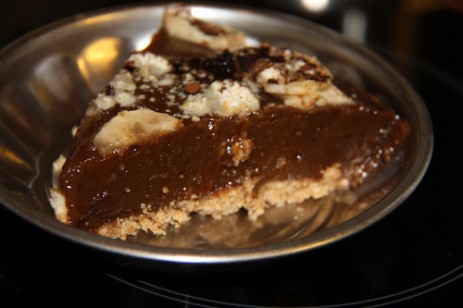from Ural with love
Maria Saraeva
Here is a recipe for delicious, low in calories and easy-to-cook cake "Shakti"
I have used my kitchen intuition again to create this cake recipe.
I often cook raw foodie desserts, some of them are based on recipes published online. And some of them are my OTG recipes… For example, I have started with cooking cream topping Shakti as a separate dessert at my kids’ desire (especially as it takes just two minutes to cook this cream). A recipe for crust is based on some other more “sophisticated” cake recipe I have found over the internet.
Ingredients
For Crust
• about 1 cup dry (not roasted) almond,
• 2 tablespoons olive oil,
• 0.5-1 teaspoon fine sea salt.
For filling / cream topping
• 4-5 ripe bananas,
• 1 sweet apple,
• 2/3 cup sweet pitted prunes,
• 1-1.5 cups drinking water,
• 1 heaped teaspoon raw carob (see its benefits review below).
Directions
Crust: Grind up 1 cup of raw almonds in the coffee grinder until they are a fine powder. At first I grinded nuts up in the blender but powder was not fine enough but I like it fine.
Add oil and salt until smooth. Transfer mixture to the prepared beautiful dish (that has reasonably high sides -typically 3 cm depending on a diameter – to serve the cake in) and press firmly into bottom of dish.
Cream topping: To make the cream topping, combine bananas, peeled and cut, a handful of prunes, apple peeled and cut into pieces (without apple it goes deliciously well), carob, and water, and blend until smooth.
Pour the mixture over the crust. I decorate the top with chopped bananas, nothing else – it looks really yummy as it is. And chill it for 5-10 minutes in a freezer until firm but not for a long time – otherwise a cake would turn into an ice cream. You may put it for 10 minutes into the fridge instead – it’s worth it as cream turns into a jelly-like wibble-wobble mass.
Bon Appetite!
Carob or carob beans (locust beans, sweet pods, sweet horns) is Sepatonia siliqua L.
Sweet coffee-flavored carob flour (but more commonly referred to as “carob powder”) obtained from the dried fruits (pods) of subtropical evergreen legume – carob or locust tree that grows along the Mediterranean Sea (Spain, Italy, Cyprus etc.). The pods are inedible in a raw form; they are dried under the sun and become sweet, and then they are ground into a powder. It is similar to cocoa powder in color but it is sweet and can be a substitute for cocoa and chocolate (sugar) in recipes, so it is good for diabetic and overweight people.
Nutritional Benefits
Carob is rich in natural dietary fibers that have a beneficial effect on the intestinal micro flora. The main nutritional features of carob are as follows:
1. Unlike cocoa, carob is naturally sweet, and one does not need to add refined sugar to make something sweet.
2. It is rich in vitamins and minerals; it has 8% of protein, and contains vitamins A, B, B2 and D. It also contains a plenty of calcium, phosphorus, potassium and magnesium, as well as iron, copper, nickel, barium and manganese.
3. Carob significantly reduces the excessive cholesterol absorption from the daily meals; its ability to reduce the cholesterol levels is twice higher than in other fiber foods.
4. In contrast to the coffee and cocoa, carob does not contain such psychotropic substances as caffeine and theobromine, found in chocolate; they make you addictive and cause allergies.
Caffeine and theobromine are stimulants. Caffeine acts directly on the brain, stimulating the senses, inspiration and alertness. Caffeine can be transmitted through breast milk, so the pregnant women are advised to refrain from it.
Caffeine has analgesic properties, as well as side effects that include anxiety, nervousness, and nausea and heart palpitations. It stimulates the production of gastric juices and acts as a diuretic, draining the vitamins B and C.
Caffeine stimulates the release of the body’s energy reserves, which means that the stock of sugar goes rapidly into the blood. This, as you know, can cause such diseases as diabetes and obesity. Carob is free from phenethylamine that causes migraines, and fromamin which besides migraines also causes allergy.
Carob does not contain oxalic acid, which prevents the body from using calcium and zinc. These minerals are essential to maintaining the skin health. The oxalic acid is found in chocolate, and it can lead to acne, especially in adolescents eating lots of chocolates.
Carob contains natural carbohydrates (sugars) and tannins. Carbohydrates make carob sticky and able to absorb water, and act as a thickener. Tannins bind toxins, thus disabling them, and making them easier to remove from the body.
Carob is not a panacea, or remedy; it is a healthier alternative to regular chocolate. Those who love chocolate can give carob a try. One can almost always substitute chocolate or cocoa in a recipe with carob powder.
Let us recap:
1. Carob is similar to cocoa powder but much sweeter, so can replace sugar in your dishes.
2. There are two types: raw and roasted carob powder.
3. Chocolate is linked to central nervous system irritation, whereas carob contains vitamins and dietary fiber. Carob is a chocolate lover delight and it lacks the health risks of chocolate as it detoxifies our body.
4. It can be used almost anywhere in the recipes – in pastry, puddings, bars – as a chocolate alternative.
5. Carob relieves diarrhea, in contrast to chocolate that can worsen this condition.
6. Unlike carob chocolate causes addiction. Chocolate prevents and carob promotes calcium and zinc absorption by our body, the latter is very necessary for human bodies, especially the skin.




